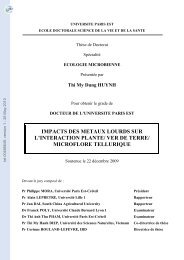- Page 1 and 2: UNIVERSITE PARIS 1 PANTHEON-SORBONN
- Page 3 and 4: Wilderness Conservation in Central
- Page 5 and 6: RemerciementsJ’adresse mes plus s
- Page 7 and 8: Cela fait près de quinze ans que j
- Page 9 and 10: tel-00508990, version 1 - 9 Aug 201
- Page 11: tel-00508990, version 1 - 9 Aug 201
- Page 15 and 16: Figure n° 12 : Macro-zones du pays
- Page 17 and 18: Figure n° 56 : Troupeau d’élép
- Page 19 and 20: Liste des AnnexesAnnexe 1 : Présen
- Page 21 and 22: DPNRFC : Direction des Parcs Nation
- Page 23 and 24: WCS : World Conservation SocietyWDP
- Page 25 and 26: Introduction1. En quête de concili
- Page 27 and 28: Introductionscientifiques, pouvoir
- Page 29 and 30: IntroductionD’abord concernant le
- Page 31 and 32: Introduction2. ProblématiqueLes qu
- Page 33 and 34: Introduction- Quels sont les change
- Page 35 and 36: IntroductionLes Hypothèses de rech
- Page 37 and 38: IntroductionUn processus inductif d
- Page 39 and 40: Introductionou imprégnés de l’h
- Page 41 and 42: Introductiontel-00508990, version 1
- Page 43 and 44: IntroductionUn questionnement const
- Page 45 and 46: IntroductionTableau 1: Présentatio
- Page 47 and 48: Introductionintégrée et de dével
- Page 49 and 50: IntroductionDans la deuxième parti
- Page 51 and 52: Partie 1Les initiatives de conserva
- Page 53 and 54: Partie 1Les initiatives de conserva
- Page 55 and 56: Partie 1Les initiatives de conserva
- Page 57 and 58: Partie 1Les initiatives de conserva
- Page 59 and 60: Partie 1Les initiatives de conserva
- Page 61 and 62: Partie 1Les initiatives de conserva
- Page 63 and 64:
Partie 1Les initiatives de conserva
- Page 65 and 66:
Partie 1Les initiatives de conserva
- Page 67 and 68:
Partie 1Les initiatives de conserva
- Page 69 and 70:
Partie 1Les initiatives de conserva
- Page 71 and 72:
Partie 1Les initiatives de conserva
- Page 73 and 74:
Partie 1Les initiatives de conserva
- Page 75 and 76:
Partie 1Les initiatives de conserva
- Page 77 and 78:
Partie 1Les initiatives de conserva
- Page 79 and 80:
Partie 1Les initiatives de conserva
- Page 81 and 82:
Partie 1Les initiatives de conserva
- Page 83 and 84:
Partie 1Les initiatives de conserva
- Page 85 and 86:
Partie 1Les initiatives de conserva
- Page 87 and 88:
Partie 1Les initiatives de conserva
- Page 89 and 90:
Partie 1Les initiatives de conserva
- Page 91 and 92:
Partie 1Les initiatives de conserva
- Page 93 and 94:
Partie 1Les initiatives de conserva
- Page 95 and 96:
Partie 1Les initiatives de conserva
- Page 97 and 98:
Partie 1Les initiatives de conserva
- Page 99 and 100:
Partie 1Les initiatives de conserva
- Page 101 and 102:
Partie 1Les initiatives de conserva
- Page 103 and 104:
Partie 1Les initiatives de conserva
- Page 105 and 106:
Partie 1Les initiatives de conserva
- Page 107 and 108:
Partie 1Les initiatives de conserva
- Page 109 and 110:
Partie 1Les initiatives de conserva
- Page 111 and 112:
Partie 1Les initiatives de conserva
- Page 113 and 114:
Partie 1Les initiatives de conserva
- Page 115 and 116:
Partie 1Les initiatives de conserva
- Page 117 and 118:
Partie 1Les initiatives de conserva
- Page 119 and 120:
Partie 1Les initiatives de conserva
- Page 121 and 122:
Partie 1Les initiatives de conserva
- Page 123 and 124:
Partie 1Les initiatives de conserva
- Page 125 and 126:
Partie 1Les initiatives de conserva
- Page 127 and 128:
Partie 1Les initiatives de conserva
- Page 129 and 130:
Partie 1Les initiatives de conserva
- Page 131 and 132:
Partie 1Les initiatives de conserva
- Page 133 and 134:
Partie 1Les initiatives de conserva
- Page 135 and 136:
Partie 1Les initiatives de conserva
- Page 137 and 138:
Partie 1Les initiatives de conserva
- Page 139 and 140:
Partie 1Les initiatives de conserva
- Page 141 and 142:
Partie 1Les initiatives de conserva
- Page 143 and 144:
Partie 1Les initiatives de conserva
- Page 145 and 146:
Partie 1Les initiatives de conserva
- Page 147 and 148:
Partie 1Les initiatives de conserva
- Page 149 and 150:
Partie 1Les initiatives de conserva
- Page 151 and 152:
Partie 1Les initiatives de conserva
- Page 153 and 154:
Partie 1Les initiatives de conserva
- Page 155 and 156:
Partie 1Les initiatives de conserva
- Page 157 and 158:
Partie 1Les initiatives de conserva
- Page 159 and 160:
Partie 1Les initiatives de conserva
- Page 161 and 162:
Partie 1Les initiatives de conserva
- Page 163 and 164:
Partie 1Les initiatives de conserva
- Page 165 and 166:
Partie 1Les initiatives de conserva
- Page 167 and 168:
Partie 1Les initiatives de conserva
- Page 169 and 170:
Partie 1Les initiatives de conserva
- Page 171 and 172:
Partie 1Les initiatives de conserva
- Page 173 and 174:
Partie 1Les initiatives de conserva
- Page 175 and 176:
Partie 1Les initiatives de conserva
- Page 177 and 178:
Partie 1Les initiatives de conserva
- Page 179 and 180:
Partie 2L’étude de cas du Parc N
- Page 181 and 182:
Partie 2L’étude de cas du Parc N
- Page 183 and 184:
Partie 2L’étude de cas du Parc N
- Page 185 and 186:
Partie 2L’étude de cas du Parc N
- Page 187 and 188:
Partie 2L’étude de cas du Parc N
- Page 189 and 190:
Partie 2L’étude de cas du Parc N
- Page 191 and 192:
Partie 2L’étude de cas du Parc N
- Page 193 and 194:
Partie 2L’étude de cas du Parc N
- Page 195 and 196:
Partie 2L’étude de cas du Parc N
- Page 197 and 198:
Partie 2L’étude de cas du Parc N
- Page 199 and 200:
Partie 2L’étude de cas du Parc N
- Page 201 and 202:
Partie 2L’étude de cas du Parc N
- Page 203 and 204:
Partie 2L’étude de cas du Parc N
- Page 205 and 206:
Partie 2L’étude de cas du Parc N
- Page 207 and 208:
Partie 2L’étude de cas du Parc N
- Page 209 and 210:
Partie 2L’étude de cas du Parc N
- Page 211 and 212:
Partie 2L’étude de cas du Parc N
- Page 213 and 214:
Partie 2L’étude de cas du Parc N
- Page 215 and 216:
Partie 2L’étude de cas du Parc N
- Page 217 and 218:
Partie 2L’étude de cas du Parc N
- Page 219 and 220:
Partie 2L’étude de cas du Parc N
- Page 221 and 222:
Partie 2L’étude de cas du Parc N
- Page 223 and 224:
Partie 2L’étude de cas du Parc N
- Page 225 and 226:
Partie 2L’étude de cas du Parc N
- Page 227 and 228:
Partie 2L’étude de cas du Parc N
- Page 229 and 230:
Partie 2L’étude de cas du Parc N
- Page 231 and 232:
Partie 2L’étude de cas du Parc N
- Page 233 and 234:
Partie 2L’étude de cas du Parc N
- Page 235 and 236:
Partie 2L’étude de cas du Parc N
- Page 237 and 238:
Partie 2L’étude de cas du Parc N
- Page 239 and 240:
Partie 2L’étude de cas du Parc N
- Page 241 and 242:
Partie 2L’étude de cas du Parc N
- Page 243 and 244:
Partie 2L’étude de cas du Parc N
- Page 245 and 246:
Partie 2L’étude de cas du Parc N
- Page 247 and 248:
Partie 2L’étude de cas du Parc N
- Page 249 and 250:
Partie 2L’étude de cas du Parc N
- Page 251 and 252:
Partie 2L’étude de cas du Parc N
- Page 253 and 254:
Partie 2L’étude de cas du Parc N
- Page 255 and 256:
Partie 2L’étude de cas du Parc N
- Page 257 and 258:
Partie 2L’étude de cas du Parc N
- Page 259 and 260:
Partie 2L’étude de cas du Parc N
- Page 261 and 262:
Partie 2L’étude de cas du Parc N
- Page 263 and 264:
Partie 2L’étude de cas du Parc N
- Page 265 and 266:
Partie 2L’étude de cas du Parc N
- Page 267 and 268:
Partie 2L’étude de cas du Parc N
- Page 269 and 270:
Partie 2L’étude de cas du Parc N
- Page 271 and 272:
Partie 2L’étude de cas du Parc N
- Page 273 and 274:
Partie 2L’étude de cas du Parc N
- Page 275 and 276:
Partie 2L’étude de cas du Parc N
- Page 277 and 278:
Partie 2L’étude de cas du Parc N
- Page 279 and 280:
Partie 2L’étude de cas du Parc N
- Page 281 and 282:
Partie 2L’étude de cas du Parc N
- Page 283 and 284:
Partie 2L’étude de cas du Parc N
- Page 285 and 286:
Partie 2L’étude de cas du Parc N
- Page 287 and 288:
Partie 2L’étude de cas du Parc N
- Page 289 and 290:
Partie 2L’étude de cas du Parc N
- Page 291 and 292:
Partie 2L’étude de cas du Parc N
- Page 293 and 294:
Partie 2L’étude de cas du Parc N
- Page 295 and 296:
Partie 2L’étude de cas du Parc N
- Page 297 and 298:
Partie 2L’étude de cas du Parc N
- Page 299 and 300:
Partie 2L’étude de cas du Parc N
- Page 301 and 302:
Partie 3Le contrôle des espaces à
- Page 303 and 304:
Partie 3Le contrôle des espaces à
- Page 305 and 306:
Partie 3Le contrôle des espaces à
- Page 307 and 308:
Partie 3Le contrôle des espaces à
- Page 309 and 310:
Partie 3Le contrôle des espaces à
- Page 311 and 312:
Partie 3Le contrôle des espaces à
- Page 313 and 314:
Partie 3Le contrôle des espaces à
- Page 315 and 316:
Partie 3Le contrôle des espaces à
- Page 317 and 318:
Partie 3Le contrôle des espaces à
- Page 319 and 320:
Partie 3Le contrôle des espaces à
- Page 321 and 322:
Partie 3Le contrôle des espaces à
- Page 323 and 324:
Partie 3Le contrôle des espaces à
- Page 325 and 326:
Partie 3Le contrôle des espaces à
- Page 327 and 328:
Partie 3Le contrôle des espaces à
- Page 329 and 330:
Partie 3Le contrôle des espaces à
- Page 331 and 332:
Partie 3Le contrôle des espaces à
- Page 333 and 334:
Partie 3Le contrôle des espaces à
- Page 335 and 336:
Partie 3Le contrôle des espaces à
- Page 337 and 338:
Partie 3Le contrôle des espaces à
- Page 339 and 340:
Partie 3Le contrôle des espaces à
- Page 341 and 342:
Partie 3Le contrôle des espaces à
- Page 343 and 344:
Partie 3Le contrôle des espaces à
- Page 345 and 346:
Partie 3Le contrôle des espaces à
- Page 347 and 348:
Partie 3Le contrôle des espaces à
- Page 349 and 350:
Partie 3Le contrôle des espaces à
- Page 351 and 352:
Partie 3Le contrôle des espaces à
- Page 353 and 354:
ConclusionAu terme de cette analyse
- Page 355 and 356:
ConclusionEntre les arènes locales
- Page 357 and 358:
Conclusiontel-00508990, version 1 -
- Page 359 and 360:
Conclusionpratiques de conservation
- Page 361 and 362:
BibliographieBibliographietel-00508
- Page 363 and 364:
BibliographieBINOT A. Présentation
- Page 365 and 366:
BibliographieCLANET J.-C. Insertion
- Page 367 and 368:
BibliographieGIBSON C. Politicians
- Page 369 and 370:
BibliographieLANGLOIS O. La distrib
- Page 371 and 372:
BibliographiePOILECOT P. La populat
- Page 373 and 374:
BibliographieSCHENK M, EFFA E, STAR
- Page 375 and 376:
AnnexesANNEXEStel-00508990, version
- Page 377 and 378:
Espaces d’intervention, Approche
- Page 379 and 380:
- un bilan régional et multisector
- Page 381 and 382:
Le site Internet du projet GEPAC es
- Page 383 and 384:
Texte de la Convention : http://www
- Page 385 and 386:
Site de la CCNUCC, lien vers le Pro
- Page 387 and 388:
tel-00508990, version 1 - 9 Aug 201
- Page 389 and 390:
⇒ Lois sur la protection de l’e
- Page 391 and 392:
tel-00508990, version 1 - 9 Aug 201
- Page 393 and 394:
Architecture de la base de données
- Page 395 and 396:
(trad. Comment ont-elles été impl
- Page 397 and 398:
12. « Innovations »L’onglet ‘
- Page 399 and 400:
mentionnent intégralement leurs r
- Page 401 and 402:
Quatre étapes sont proposées : 1)
- Page 403 and 404:
prestataires privés. Pour ce faire
- Page 405 and 406:
tel-00508990, version 1 - 9 Aug 201
- Page 407 and 408:
tel-00508990, version 1 - 9 Aug 201
- Page 409 and 410:
Annexe 5Enquêtes en milieu village
- Page 411 and 412:
4) Quels sont les droits d’exploi
- Page 413 and 414:
Niveau perception : vise à mettre
- Page 415 and 416:
3 Guides d’entretiens utilisés d
- Page 417 and 418:
Occupation de l’espace : Divagati
- Page 419 and 420:
Qui vous a donné des animaux en co
- Page 421 and 422:
tel-00508990, version 1 - 9 Aug 201
- Page 423 and 424:
Carte 1 : Le positionnement et l’
- Page 425 and 426:
Au départ des scènes Spot, trois
- Page 427 and 428:
Fig. 2 : Le PVI est un calcul de di
- Page 429 and 430:
de relevés a été estimé à envi
- Page 431 and 432:
La plupart des sites ainsi caracté
- Page 433 and 434:
chaque espèce d’un relevé la va
- Page 435 and 436:
en colonne les types de sol corresp
- Page 437 and 438:
tel-00508990, version 1 - 9 Aug 201
- Page 439 and 440:
tel-00508990, version 1 - 9 Aug 201
- Page 441 and 442:
Tous les villages, groupes de villa
- Page 443:
La conservation de la Nature en Afr
















